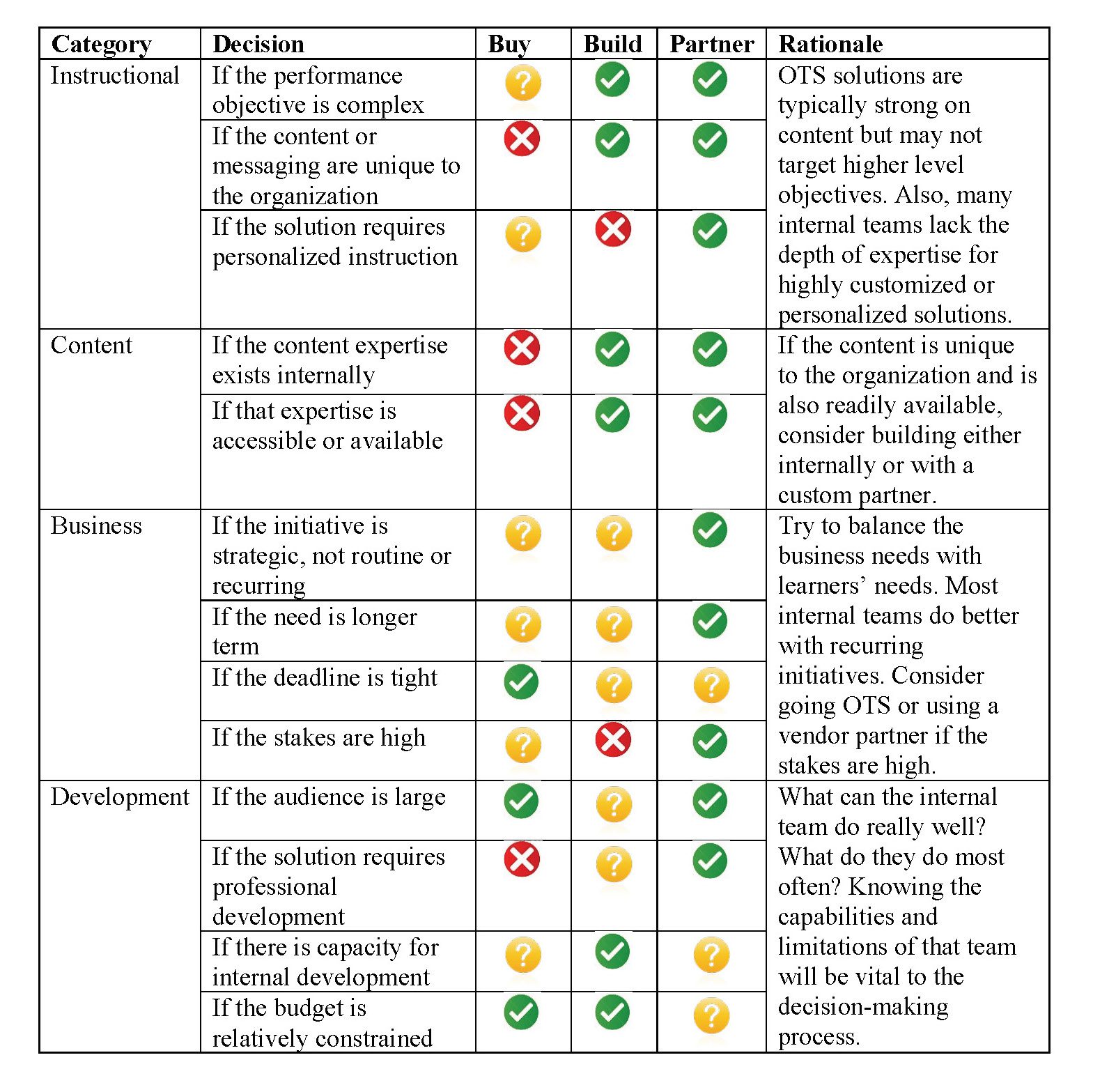The deciding factors for these options will depend on a holistic context.
by Michael J. Noble
July 13, 2016
 The decision to buy, build or partner on learning usually goes in cycles. A leader may start building internal team resources and skills only to shift to a vendor strategy as business stakeholders become more demanding. That trend may continue until budgets dry up again, and the cycle repeats.
The decision to buy, build or partner on learning usually goes in cycles. A leader may start building internal team resources and skills only to shift to a vendor strategy as business stakeholders become more demanding. That trend may continue until budgets dry up again, and the cycle repeats.
Such cycles typically have more to do with budgetary pressures than with performance objectives. Yet, the business needs and performance targets for most organizations are sufficiently complex to warrant a combination approach to learning and development of buying the best of what already exists, building what the internal team can do really well, and potentially partnering with a custom vendor for strategic initiatives.
Before analyzing the variables that comprise this combination approach, let’s clearly define each of these terms:
- Buy: Off-the-shelf (OTS) content exists for a lot of soft skills or general topics. Within this category, vendors offer general content libraries, specialized and technical content, or branded content based on a popular methodology or best-selling book. This model likely entails buying a license or subscription for a defined period of time. When such content is customized, these customizations are largely cosmetic.
- Build: Internal design and development teams vary widely. Some team members may be able to create basic e-learning courses using the templates present in most authoring tools. Other team members may be strong on needs analysis or curriculum design. Often an internal team’s ability to assess needs or understand the business context exceeds members’ development skills.
- Partner: A custom development partner should be able to offer the full range of learning solutions, professional media development, and leadership on current trends and innovations. For subject-matter expertise, they may depend on either the internal team or on a content vendor.
Deciding which learning approach to use for a particular need is a judgment call that improves with experience and expertise, but there are a number of factors that can provide guidance.

The buy strategy is going to work best in situations where access to the best content trumps other factors such as budget or design quality. This may be the case with highly specialized content areas such as at the Risk Management Association or TRACE, or with original, branded content like that used at CEB and O.C. Tanner.
For example, if the stakeholder or project sponsor is a sales executive who already embraces a particular sales methodology, a sales training program already based on that methodology may be the best way to meet expectations. If, after evaluating that program, the determination is made to customize, the team can always build complementary learning resources to accompany the OTS courseware.
When Building Works
The build strategy is going to be best to meet predictable day-to-day needs where solutions can be consistent. But some organizations may not have the necessary volume or scalability to justify in-house video professionals, sound engineers, graphic designers, motion designers, illustrators, animators, programmers, etc., for unusual, strategic initiatives. There are authoring systems like Articulate and Lectora available to enable and instructional designers to create their own programs based on existing templates.
Knowing that certain business units have routine requirements for compliance training or product knowledge allows internal teams to focus their limited resources and abilities to produce the few types of courseware that groups require. Defining what kind of learning the internal team can offer allows that team to become experts and to deliver the best of what’s possible within those definitions.
When Partnering Works
The decision to use a vendor partner should be based on a strategic need for innovation. This isn’t redundant with an internal team’s capabilities — it expands and augments their abilities.
If the internal team is handling the organization’s predictable, more transactional needs, the right vendor partnership will be able to handle large, high-stakes initiatives that require change management, internal communications and thought leadership, in addition to professional media development. If the internal team typically handles compliance courses, maybe it shouldn’t tackle the rollout of an enterprisewide change that could impact the company’s direction.
Ultimately, the deciding factors for these options will depend on a holistic context that balances learner needs, business needs, content expertise and development feasibility. Developing a deliberate strategy for such decisions, as opposed to being a victim of reactionary swings or prevailing winds, increases the likelihood of success by increasing available options.
Michael Noble is the chief learning officer for AllenComm. To comment, email editor@clomedia.com.



